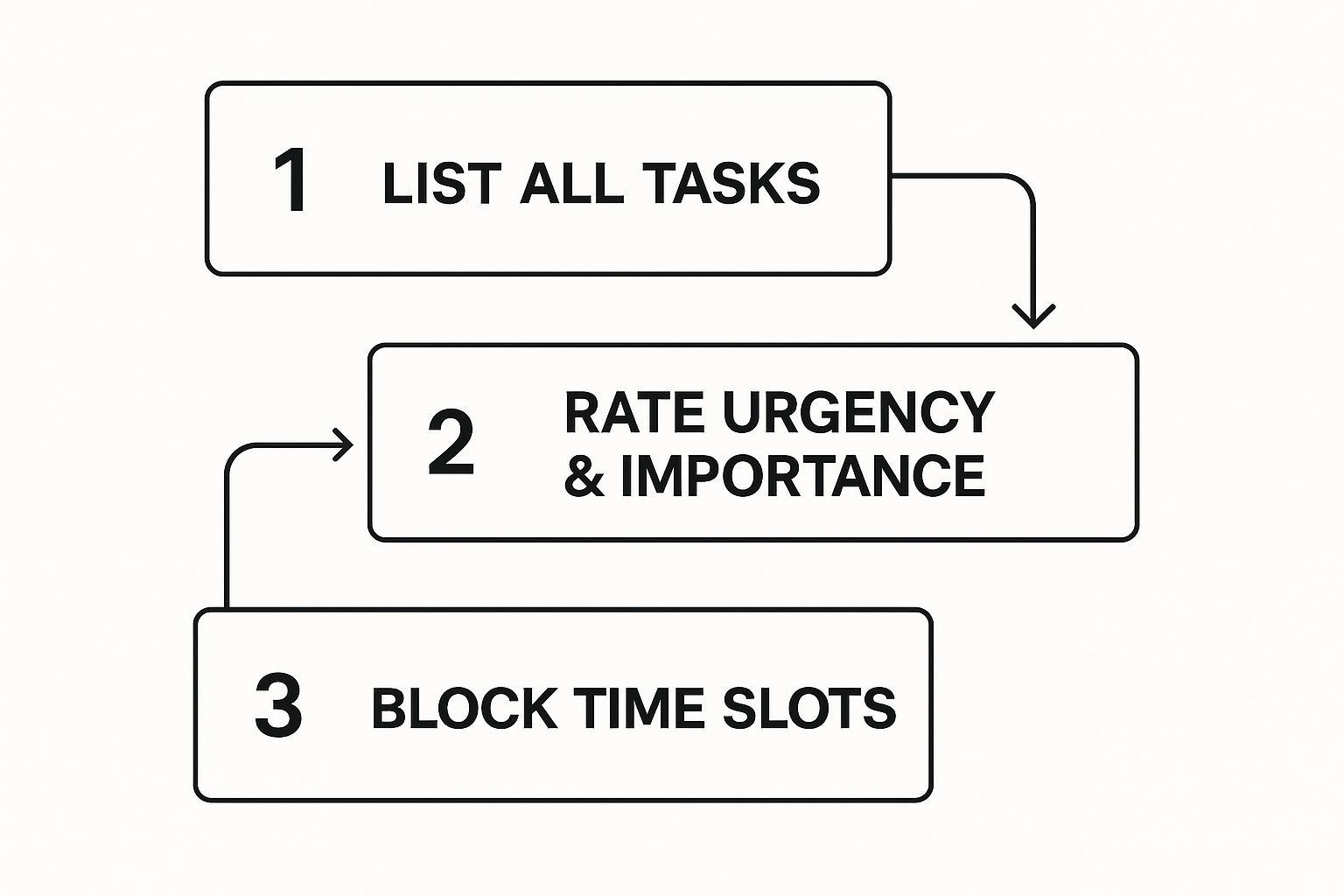
Time Management for Entrepreneurs Ultimate Guide
Published on 2025-07-13
Mastering your schedule as an entrepreneur isn't about finding more hours in the day. It’s about making the hours you have count. This means a fundamental shift in how you think—moving away from the "hustle culture" badge of being constantly busy and focusing instead on being genuinely productive.
The secret isn’t working harder; it’s about getting crystal clear on where your time goes, zeroing in on tasks that actually move the needle, and building a framework that fiercely protects your focus.
Stop Being Busy and Start Being Productive
If you're an entrepreneur, your to-do list probably feels like it has a life of its own. It grows, it looms, and it never, ever sleeps. The default reaction is often to just put your head down and "hustle harder," but that's a one-way ticket to burnout, not a breakthrough. The first and most important step is to stop glorifying busyness and start measuring your work by its results.
This requires taking a hard, honest look at where your hours are actually spent. The entrepreneurial grind is no joke and it takes a toll. While many small business owners work a reasonable 30 hours a week, a staggering 19% are pushing past the 50-hour mark. It’s no surprise that this intensity is linked to mental health, with nearly 88% of entrepreneurs reporting struggles and burnout affecting around 34.4%. You can dig into more eye-opening data in these time management statistics from Clockify.me.
Conduct an Honest Time Audit
You can't manage what you don't measure. For one full week, I want you to track everything you do. And I mean everything. This isn't an exercise in self-criticism; it's about collecting raw, objective data. Be brutally honest with yourself. If you spent 45 minutes lost in a social media rabbit hole, write it down. No judgment.
The real power of a time audit is in the clarity it provides. It exposes the often shocking gap between what you think you're doing and where your time is actually going. That's where real change begins.
After you have a week's worth of data, it's time to categorize. A simple but effective method is to label every task as either "Growth" (like sales calls or product development), "Admin" (invoicing, email), or "Firefighting" (customer complaints, urgent bug fixes).
This simple act of sorting will immediately show you where your energy is being funneled. You might be horrified to discover how much time is eaten up by low-impact admin work that could be automated or handed off. This is a common trap with activities like social media, which can feel productive but often lack a clear strategy. Our guide on building a social media content plan can help you transform that time-suck into a genuine growth driver.
Your Weekly Time Audit Template
Here's a simple template to get you started on your time audit. Just tracking your activities for a week gives you an undeniable, visual map of where your most precious resource—your time—is going. Think of it as creating the foundational blueprint for a more productive and sane work life.
| Time Block | Task Category (e.g., Growth, Admin, Firefighting) | Specific Task | Impact (High/Medium/Low) |
|---|---|---|---|
| Monday 9-10 AM | Firefighting | Responding to urgent support tickets | Medium |
| Monday 10-12 PM | Growth | Outbound sales outreach | High |
| Monday 1-2 PM | Admin | Sorting and replying to non-urgent emails | Low |
| Monday 2-4 PM | Growth | Planning the Q4 marketing campaign | High |
By the end of the week, you'll have a much clearer picture. That clarity is what you'll use to start making strategic changes, cutting out the noise, and doubling down on what truly matters.
Build a Productivity System That Actually Works

As entrepreneurs, we often fall into the trap of setting a vague goal to "be more productive." It sounds great in theory, but without a real system, it's just a wish. True productivity isn't about brute force or willpower; it's about building a smart, intentional framework that connects your daily to-do list to your biggest business goals.
Let's get past the generic advice. It's time to stop letting your day happen to you and start designing it with purpose. Two of the most effective methods I've seen successful founders use are task batching and time blocking. These aren't just buzzwords; they’re practical ways to carve out the uninterrupted time you need for meaningful work.
Batch Your Work to Reclaim Your Focus
Think about how much energy you lose by constantly switching gears. You answer an email, then jump into designing a graphic, then take an unexpected sales call. This mental whiplash, known as context switching, is a notorious productivity killer.
Task batching is the simple, powerful antidote. You just group similar tasks together and knock them out in one focused session.
For instance, a founder I coached was constantly derailed by support emails trickling in all day. She switched to handling all customer service in two dedicated 45-minute blocks—one in the morning and one in the afternoon. That simple change freed up hours of fragmented time, which she immediately reinvested into deep work on product development.
Batching isn't about multitasking; it's the exact opposite. It's about giving one type of task your complete attention for a set period. You'll find you work faster and produce higher-quality results.
Block Your Time to Protect Your Priorities
Once you have your batches of tasks, the next move is to give them a specific home on your calendar. This is time blocking. You're not just making a list of what needs to get done; you're deciding when it will get done.
You have to treat these blocks like unbreakable appointments with your most important client: your business.
Here’s what this might look like for a solo founder juggling it all:
- Monday 9 AM - 12 PM: Deep Work (Write blog posts and newsletter)
- Tuesday 2 PM - 4 PM: Batch Block (Record and edit all social media videos for the week)
- Wednesday 1 PM - 3 PM: Admin Block (Process invoices, pay bills, and clear out the inbox)
- Thursday 10 AM - 12 PM: Growth Block (Prospecting and sales outreach calls)
Suddenly, your calendar transforms from a passive record of meetings into a proactive roadmap for the week. This ensures that the important-but-not-urgent work—like marketing and long-term planning—actually happens.
Design Your Week with Thematic Days
Want to take it to the next level? Assign a specific theme to each day of the week. This is a game-changer for maintaining momentum and making sure every part of your business gets the attention it deserves.
Here's a sample structure:
| Day of the Week | Theme | Example Activities |
|---|---|---|
| Monday | Marketing & Growth | Plan social media, write ad copy, outreach. |
| Tuesday | Client Work | Fulfill orders, client meetings, project updates. |
| Wednesday | Product & Ops | Improve features, streamline processes. |
| Thursday | Finance & Admin | Invoicing, bookkeeping, review metrics. |
| Friday | Planning & Learning | Set next week’s goals, professional development. |
This simple structure eliminates that dreaded "what should I be doing right now?" paralysis. When you wake up on "Marketing Monday," you know exactly which hat to put on and what to focus on. By combining these methods, you create a reliable productivity engine that truly works for you.
Master Prioritization and Make Better Decisions
As an entrepreneur, the firehose of tasks never stops. That's a given. But the real secret to success isn't just managing that flow; it's learning to tell the difference between what feels urgent and what's actually important.
Developing that instinct is a superpower. It’s not about finding more hours in the day—it’s about being ruthless with how you use the ones you have. The best tool I've found for this is the Eisenhower Matrix. It's a dead-simple framework that helps you sort every single task into one of four buckets.
The Four Quadrants of Entrepreneurial Action
The magic of the matrix is how it forces you to evaluate tasks based on two simple criteria: urgency and importance. This simple act moves you from constantly reacting to everything that pops up to proactively driving your business forward.
Here’s how it breaks down for a founder:
Do First (Urgent & Important): These are the fires you have to put out now. A major server outage, a key client with a critical issue, a make-or-break investor deadline. There’s no debating these; they go to the top of the list.
Decide When (Not Urgent & Important): This is where you actually build your business. Think long-term strategy, planning your next big product launch, or nurturing key partnerships. These are the tasks that create real value, and you have to deliberately carve out time for them.
Delegate (Urgent & Not Important): These are the noisy tasks that scream for attention but don’t contribute to your core goals. Responding to routine emails, scheduling calls, booking travel—they feel urgent but are perfect candidates to hand off to a virtual assistant or automate.
Delete (Not Urgent & Not Important): The black hole of productivity. Mindlessly scrolling through social media feeds, sitting in on meetings that don't need you, or reorganizing your inbox for the tenth time. Get savage about cutting these out.
This visual helps clarify the process.

To make this practical, let's look at how this applies to common founder tasks.
The Eisenhower Matrix for Founders
| Quadrant | Action to Take | Example Entrepreneur Task |
|---|---|---|
| Urgent & Important | Do it now | Fixing a critical bug in your software before a demo. |
| Not Urgent & Important | Schedule it | Blocking out Friday morning to map your Q3 marketing plan. |
| Urgent & Not Important | Delegate it | Asking your assistant to handle all meeting scheduling. |
| Not Urgent & Not Important | Delete it | Attending a weekly status update you don't contribute to. |
Getting a clear inventory of your tasks is the first step. Only then can you start slotting them into your calendar based on their real strategic value, not just how loudly they're shouting for your attention.
The biggest trap for founders is living in that "Urgent & Important" quadrant, constantly putting out fires. Your goal should be to shift as much of your time as possible to "Not Urgent & Important," where strategic, long-term growth actually happens.
Of course, once you’ve prioritized, you have to communicate those decisions clearly, especially when you're delegating or setting expectations with your team. If you want to sharpen that skill, check out our guide on essential business writing tips and tricks.
Making this matrix a habit will completely change your relationship with your to-do list. It stops being a source of anxiety and becomes what it should be: a strategic roadmap for building your business.
Protect Your Focus and Get More Deep Work Done

As an entrepreneur, your most valuable asset isn’t your killer product or your marketing budget. It’s your focus. In a world of endless pings and notifications, the ability to do deep, uninterrupted work is what separates the founders who thrive from those who are just perpetually stressed.
The cost of constant interruptions is truly staggering. One study found that the average office worker gets distracted every 3 minutes and 5 seconds. What's worse? It can take over 23 minutes just to get back into the groove. Combine that with the 28% of the workweek already eaten up by email, and it's easy to see how your most productive hours simply evaporate. If you want to dive deeper into the numbers, this eye-opening research breaks it all down.
This constant back-and-forth, or "context switching," is a silent productivity killer. Protecting your focus isn't a nice-to-have; it's a core business strategy that demands a deliberate approach.
Engineer a Distraction-Free Environment
Your physical and digital spaces can either be a hotbed for distractions or a sanctuary for focus. The choice is yours.
A great place to start is your desk. A messy workspace creates mental clutter, constantly pulling at your attention in subtle ways. Clear it off. Then, tackle your digital world. Close every browser tab that isn't essential for the task at hand, silence all desktop notifications, and put your phone on "Do Not Disturb" mode—or better yet, in another room.
The idea is to create friction. If you have to physically get up and walk to another room to check your phone, you're much less likely to do it on a whim.
Your ability to enter a state of deep work is directly proportional to the walls you build around your attention. When you're locked in on your most important tasks, make it hard for the outside world to get in.
Master the Art of Communicating Your Focus Time
Just blocking off "deep work" time on your calendar won't cut it if your team, clients, or even family don't know to respect those boundaries. This is where clear communication becomes a critical part of time management for any entrepreneur. You have to set and enforce your "focus hours."
Treat these time blocks with the same reverence you'd give a major client meeting.
- Share your calendar: Make your focus blocks visible to your team. Don't be vague; label them clearly, like "Deep Work – Do Not Disturb" or "Writing Time – Emergencies Only."
- Set the ground rules: Let your team know that during these hours, you won't be on Slack or checking email unless there's a genuine fire to put out. Be sure to define what actually counts as an emergency.
- Lead by example: When you respect your own focus time, others will learn to respect it too. This has the added benefit of encouraging your team to protect their own focus, fostering a more productive culture for everyone.
This isn’t about being unavailable. It’s about creating a structure that lets you tackle the high-impact, strategic work that only you can do. By guarding your focus, you're not just getting more done—you're making sure you get the right things done, pushing your business forward one uninterrupted session at a time.
Scale Yourself with Smart Automation and Delegation
Let's be honest: you can't do it all. And you shouldn't even try. As an entrepreneur, your time and attention are your most precious—and limited—resources. The only way to truly grow is to learn how to multiply your impact, and that comes from putting technology and people to work for you.
A great starting point is to ruthlessly cut out the repetitive, low-impact tasks that drain your energy. Think about the daily grind: manually punching customer data into a CRM, chasing down leads with follow-up emails, or trying to keep up with social media posting. These are prime candidates for automation.
Make Technology Your Digital Assistant
Tools like Zapier, Make, and IFTTT aren't just for tech-savvy developers anymore. They’re essential for any founder serious about getting their time back. You can set up simple workflows that connect your favorite apps, basically putting all that tedious administrative work on autopilot.
Imagine this scenario: a new lead fills out a form on your website. Instead of you stopping what you're doing to add them to your CRM, create a follow-up task, and then send a welcome email, a simple automation can do all of that in a blink. You can even go a step further and automate your LinkedIn posts to maintain a consistent presence without the daily scramble.
This isn't just a nice-to-have; it's a strategic imperative. A recent study found that nearly 40% of entrepreneurs are bringing in new AI tools specifically to save time. It adds up, too—they're saving an average of six hours a week, which comes out to 310 hours a year. Despite these efficiency gains, an overwhelming 82% of founders still lose sleep over their business.
The Art of Letting Go: Strategic Delegation
Automation is powerful, but the other side of the coin is people. I see so many entrepreneurs hit a wall because they refuse to delegate. They worry about losing control or feel that nobody can do the job quite as well as they can. That mindset, while understandable, is a direct bottleneck to growth.
Delegation isn't about just dumping tasks on someone else. It's about building systems and empowering a team so the business can thrive even when you're not in the weeds.
When you delegate, you aren't "giving up" tasks. You're "buying back" your time to focus on the high-level, strategic work that only a founder can do.
Start small. Look for tasks that are teachable, happen regularly, and don't require your unique vision or expertise. Here are a few common ones to start with:
- Inbox and calendar management: A good virtual assistant (VA) can triage your email and guard your calendar, instantly saving you several hours a week.
- Bookkeeping and invoicing: Handing this off to a professional not only frees up your time but also prevents expensive mistakes.
- Basic customer support: Train a team member or VA to handle common customer questions and issues.
- Content and social media: You don't need to write every blog post or schedule every tweet. Hire a freelancer to handle content production.
Ultimately, learning how to delegate tasks effectively is one of the most critical skills you can develop. It takes clear communication, trust, and a real willingness to let go. When you combine smart automation with strategic delegation, you're no longer limited by the hours in your day—you're building a business that can truly scale.
Frequently Asked Questions

As an entrepreneur, trying to get a handle on your time often brings up some tricky questions. We get it. Here are some straightforward answers to the things we see founders struggle with the most when trying to get their schedules and productivity on track.
What’s the Single Best Technique for a New Entrepreneur?
If you're just starting out, the most powerful thing you can do is combine ruthless prioritization with time blocking. It's a simple one-two punch that cuts right through the chaos of a new venture.
First, figure out the one to three tasks for the week that will actually move the needle for your business. These are your make-or-break activities, the ones that create real value. Then, you literally block off time in your calendar to do them, and you don't let anything interrupt you.
Think of these blocks of time like a meeting with your most important investor. You wouldn't cancel that, would you? This simple discipline stops your schedule from being a free-for-all of low-impact, reactive tasks.
It's a foundational habit that forces you to be proactive, not just busy. It’s the difference between building your business and just running around putting out fires, a trap that snares way too many new founders.
How Can I Manage My Time When My Schedule Is So Unpredictable?
When every day feels chaotic, a rigid, minute-by-minute schedule is doomed to fail. The real secret is to create structure within the chaos, not to fight it.
A great way to do this is by "theming" your days. You’re still flexible, but you have a focus. For instance:
- Mondays: All things marketing and lead generation.
- Tuesdays: Head-down on product development and ops.
- Wednesdays: Reserved for client calls and sales meetings.
This gives your week a general rhythm. You know which hat you're supposed to be wearing each day, which makes it much easier to get back on track after you get pulled into something unexpected.
Another pro tip: keep a running list of "quick win" tasks. These are important, pre-vetted things you can knock out in less than 30 minutes. When a meeting gets canceled or you suddenly find a free half-hour, you can jump straight to that list instead of wasting time figuring out what to do. It’s a brilliant way to turn those random pockets of time into productive moments.
Should I Use a Digital Calendar or a Paper Planner?
Ah, the classic digital vs. analog debate. Here’s the honest answer: the best tool is the one you actually use consistently. It’s less about the technology and more about your personal workflow.
Digital tools like Google Calendar are fantastic for scheduling meetings, setting automatic reminders, and sharing your availability with your team. They shine when it comes to collaboration and managing appointments.
On the other hand, there’s something powerful about a physical planner. The simple act of writing down your priorities for the day can create a much stronger mental commitment to getting them done.
Honestly, many of the most successful entrepreneurs I know use a hybrid system. They’ll use a digital calendar for all the appointments, but they start every single morning with a pen and a notebook to map out their top three priorities. My advice? Try both and see what sticks.
Feeling the pressure to create great LinkedIn content on top of everything else? autoghostwriter is designed for busy founders like you. It uses smart AI to help you write authentic, high-quality posts that grab attention and get people talking. Stop losing hours to content creation and start building your network.
Check out our plans and see how it works at https://autoghostwriter.com.